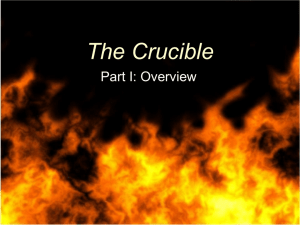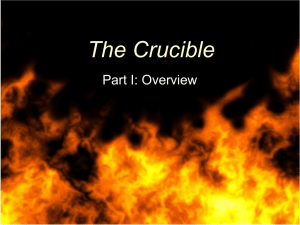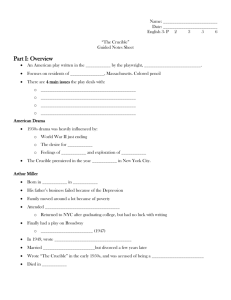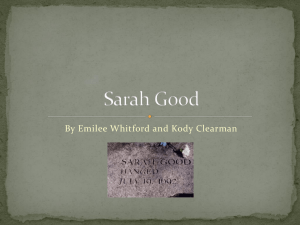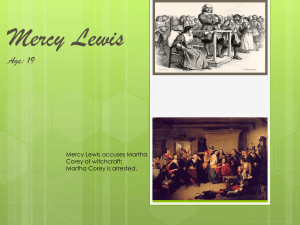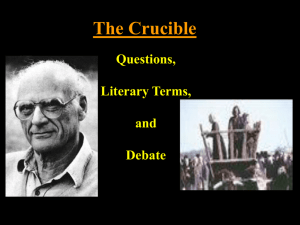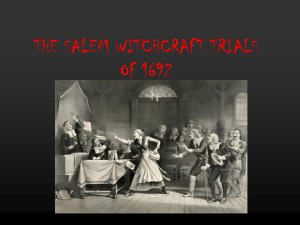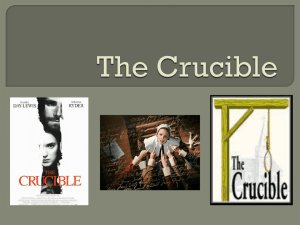The Crucible
advertisement
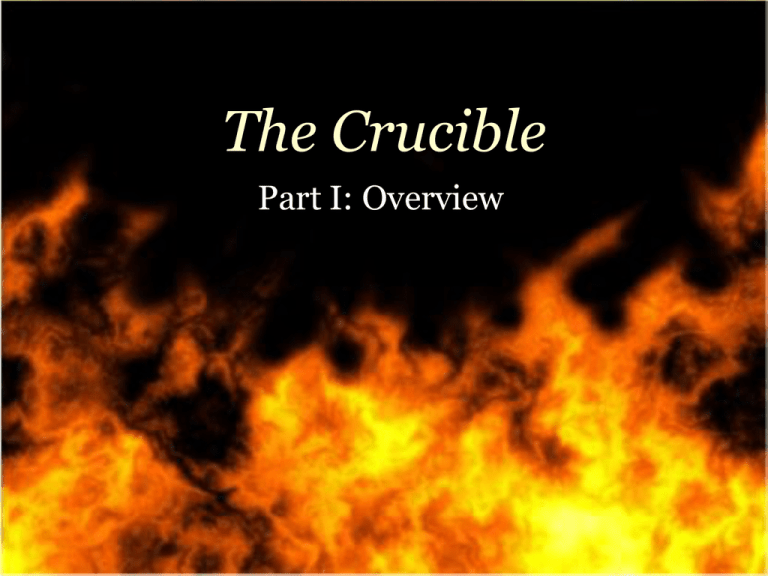
The Crucible Part I: Overview Part I: Overview American play Written in the 1950s Playwright: Arthur Miller Focuses on residents of Salem, Massachusetts Issues: greed, guilt, motivation, morality Overview: American Drama 1950s drama was heavily influenced by: – World War II just ending – The desire for change – Feelings of guilt and exploration of identity The Crucible premiered in January 1953 in New York City. Overview: Arthur Miller Born in 1915 in New York City His father’s business failed because of the Depression Family moved around a lot because of poverty Attended the University of Michigan Overview: Arthur Miller Returned to NYC after graduating college – No luck with writing! Finally had a play of his on Broadway – “All My Sons” (1947) In 1949, wrote “Death of a Salesman” Overview: Arthur Miller Married Marilyn Monroe (lucky guy!) – Divorced after a few years – Had three wives altogether Wrote “The Crucible” in the early 1950s – Was accused of being a Communist Died in 2005 Overview: Salem, Massachusetts Located on the coast of Massachusetts Settled mainly by Puritans in 1626 – A group of people who left England so they could practice religious freedom – Often let their religious beliefs guide their daily lives Most known for the Salem Witch Trials of 1692 – Nickname: “The Witch City” Puritans arriving in Massachusetts Salem Witch Trials Memorial Overview: Issues Greed: How do you define greed? Is greed ever a good thing? Guilt: What leads people to feel guilt? Motivation: What is the biggest motivator in your life? Morality: List your top three “moral rules.” How do these fit into our ideas of America? Remember, this class is about American literature as much as possible! Be thinking about this question every time we read a text. The Crucible Part II: Salem Witch Trials Salem Witch Trials Occurred from June through September of 1692 in Salem Puritan group of people was involved Townspeople were in a state of hysteria about witches/evil The Facts Young girl named Betty Parris became ill – Fever, extreme pain, running around the house More children in Salem became ill – Ann Putnam, Mercy Lewis, Mary Walcott Doctors were called in to find the reason for this sickness But… Doctors couldn’t explain illness, so they defaulted to “witchcraft” – Townspeople were easily convinced – A servant in town was suspected of witchcraft Townspeople decided to arrest the servant, Tituba, and an older woman for witchcraft It continues… More and more people were arrested and charged with witchcraft – The punishment for witchcraft was DEATH by HANGING – In order to live, some people “confessed” to practicing witchcraft. The Casualties Nineteen men and women were put to death for witchcraft. One man, Giles Corey, was also pressed to death. Why did this happen? People were suspicious/fearful – A book about witchcraft had just been published by Cotton Mather – People were at war with Native Americans – Death/evil were on the mind of many (because of fighting and disease) – Puritan culture easily accepted the devil as the source of evil/wrong in life Other Explanations Teenagers in town were bored and got carried away – Dancing, flirting, etc. not allowed at all! – All of the accusers were teenage girls Some of the accusers were jealous people – An easy way to get rid of people they didn’t like! General sense of depression in town – Not a lot of wealth/happiness/freedom The Crucible Part III: Historical Context The Appeals of Communism America’s Great Depression left people upset about the American government – Everyone deserves basics (food, clothing) – Communism offers that promise 1939: 50,000 Americans were members of the Communist party. Then, World War II Begins 1941: America begins fighting against Germany (and others) Communism was seen as “un-American” because of the surge in patriotism 1945: America won World War II – Defeated the German government of fascism Fascism: government led by a dictator that suppressed opposition of any kind America vs. The Soviet Union America was emerging as a world power, but: – The Soviet Union was its main competition And: – The Soviet Union was Communist America and The Soviet Union competed against each other for world power in: – Space travel – Nuclear weapon development – In effect, government style Communism came to be seen as “evil” 1950: Julius and Ethel Rosenberg arrested – Charged with supplying atomic bomb secrets to the Soviet Union Soviet Union developed the atomic bomb (from the secrets provided) Communism became the opposite of everything America represented! The Effects of Hysteria: The “Red Scare” Begins Red: color of Communism Symbol of Communism: Hammer and Sickle – Why is this the symbol of communism? Enter: Joseph McCarthy and the HUAC HUAC HUAC: House Committee of Un-American Activities – This committee questioned Americans who were suspected of being Communists – They summoned thousands of people to testify Goal: to get as many names of “Communists” as possible Joseph McCarthy The ruthless head of the HUAC Claimed he had a list of 205 Communists who worked for the US Government Was the ringleader of the Red Scare Who Was Suspected of Being a Communist? Filmmakers, directors, actors were accused of attending communist meetings Certain politicians were also targeted These people had two options: – Admit to being a Communist and tell McCarthy names of other people who attended Communist meetings – OR – Refuse to admit anything (or rat out others) and be blacklisted Can’t get work if blacklisted! Walt Disney Why would Disney be targeted? Ronald Reagan Martin Luther King, Jr. Arthur Miller “The Crucible” and Communism Allegory: work of literature that tells one story on the surface while referring to another sub textually – Comparing the play to the Red Scare Can you see how these historical events are similar to those of the Salem Witch Trials? Part III: Historical Context Complete the Venn diagram in your notes packet. This Venn diagram should make connections between the Salem Witch Trials and the Communist Hunt of the 1950s. The Crucible Part IV: Character Introduction Part IV: Character Introduction Protagonist=Main character Antagonist=Who/what the protagonist is “fighting” Character Introduction Abigail Williams: – Leader of the group of girls – Having an affair with John Proctor – Smart, manipulative, jealous Character Introduction John Proctor: – Farmer – Married, but having an affair with Abigail – Proud and (usually) honest Character Introduction Elizabeth Proctor: – John Proctor’s wife – Moral and honest – Sometimes seen as “cold” Character Introduction The Girls: – Betty Parris: Daughter of the town minister – Ruth Putnam: Daughter of a wealthy, greedy landowner – Mary Warren: Servant of the Proctors – Mercy Lewis: Servant of the Putnams Character Introduction Reverend Parris: – Town minister – Paranoid – Concerned with what others think of him Character Introduction John Hale: – “Expert” on witchcraft – Asked to come to Salem for his knowledge – Intelligent and logical Character Introduction Tituba: – Slave from Barbados – Performs voodoo – Accused of witchcraft Other Cool Characters Giles Corey: – Older man who is pressed to death – Outspoken – Files lawsuits frequently Rebecca Nurse – Kind, older woman accused of witchcraft – Very moral and sensible Protagonist/Antagonist Which character are YOU most like? Who do you think the protagonist is? Who/what is the antagonist?
